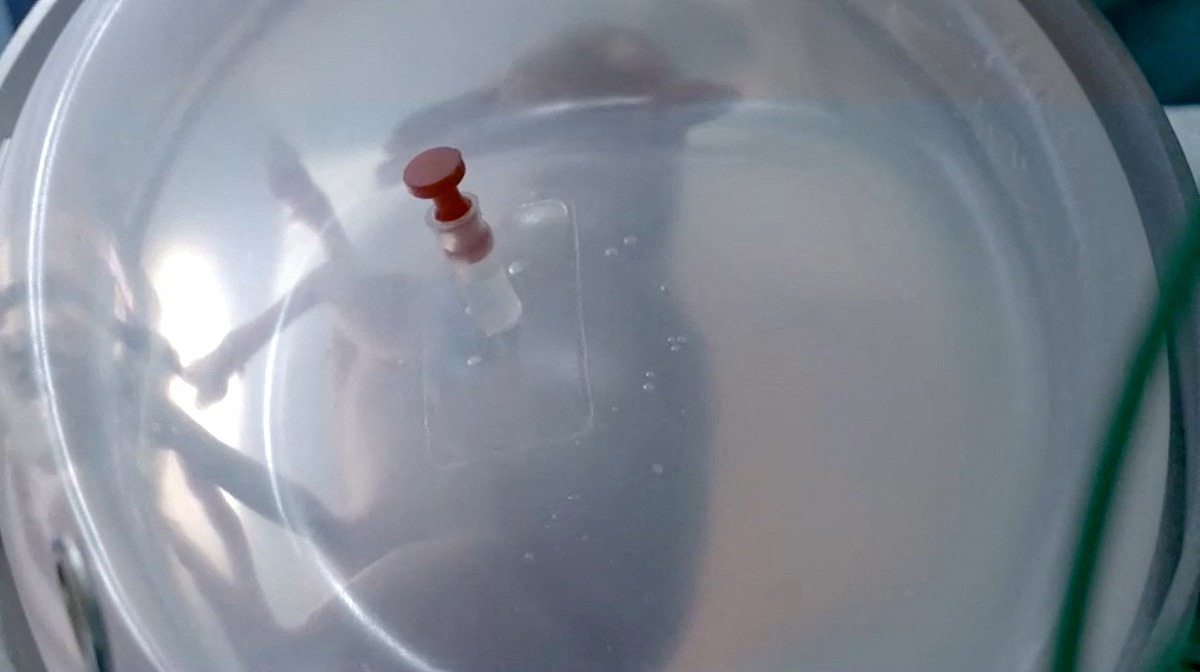
A premature lamb fetus is seen inside an artificial womb developed by researchers from BCNatal in Barcelona, in this screen grab from a video released on June 19.
11:51 JST, July 27, 2023
BARCELONA (Reuters) — Researchers in Barcelona are trying to “trick nature” by creating an artificial womb for extremely premature babies after tests on animals kept fetuses alive for 12 days.
Their artificial placenta prototype recreates a protective environment with a translucent container made of biocompatible material inside which the fetus’ lungs, intestines and brain can continue to develop.
It is connected to an amniotic fluid circulation system that maintains the fetus isolated from external stimuli but accessible for ultrasound controls and monitoring.
Babies born after six months of pregnancy or less are considered extremely premature with a high risk of death or disability. The World Health Organization’s latest figures show that around 900,000 such babies died worldwide in 2019.
“We try to develop a system that allows us to keep a fetus outside its mother but still in the fetal conditions: that it continues to breathe through the umbilical cord … that we can feed it through the umbilical cord, that it lives surrounded by fluid at a constant temperature,” project head Eduard Gratacos told Reuters.
He leads a team of 35 from BCNatal medical research center — a fusion of the maternal-fetal medicine and obstetrics departments of two Barcelona hospitals — and Fundacion La Caixa, a private organization funded by Caixabank.
The team has conducted preclinical studies with lambs, where they achieved 12-day fetus survival, and plans to also test with pigs before proposing a human trial in a few years.
“The highly complex project spans many different specialties of medicine and requires engineers of different types. It’s a challenge, it’s extremely delicate to achieve this, to trick nature to make this possible,” Gratacos said.
Among a few such projects worldwide, one group of scientists at the Children’s Hospital of Philadelphia managed to keep animal fetuses alive for 28 days.
Kelly Werner, assistant professor of pediatrics at Columbia University, told the Science Media Centre the Spanish team’s positive results must be rigorously tested in clinical trials on humans to check for safety and side effects.
“Although it is an exciting development, the artificial placenta is not intended to replace a natural placenta,” Werner said. “That is, despite these advancements, we still should make every effort to support maternal health and decrease risk factors that lead to preterm birth.”
"Science & Nature" POPULAR ARTICLE
-

Genome Study Reveals Milestone in History of Cat Domestication
-

Big Leap in Quest to Get to Bottom of Climate Ice Mystery
-

Security Camera Footage Vulnerable to Outside Access; Investigation Finds 3,000 Pieces Exposed Online
-

Paws on Parade: Nairobi’s Dogs Dazzle at ‘Pawchella’
-

Japan Set to Participate in EU’s R&D Framework, Aims to Boost Cooperation in Tech, Energy
JN ACCESS RANKING
-

Keidanren Chairman Yoshinobu Tsutsui Visits Kashiwazaki-Kariwa Nuclear Power Plant; Inspects New Emergency Safety System
-

Imports of Rare Earths from China Facing Delays, May Be Caused by Deterioration of Japan-China Relations
-

Tokyo Economic Security Forum to Hold Inaugural Meeting Amid Tense Global Environment
-

University of Tokyo Professor Discusses Japanese Economic Security in Interview Ahead of Forum
-

Japan Pulls out of Vietnam Nuclear Project, Complicating Hanoi’s Power Plans























